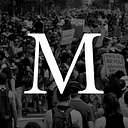Member-only story
HISTORY
How Slave Badges Expose America’s Shameful Legacy of Black Surveillance
Black freedom was subject to White interpretation
While George Orwell’s dystopian novel Nineteen Eighty-Four portrays a society where the government attempts to control every facet of citizens’ lives, this scenario is not hypothetical for Black people living in America. Since the first enslaved person, Estevanico, arrived near modern-day St. Petersburg, Florida, in 1528, White people sought to control the lives of Black people in this country. To accomplish this feat, they created a system of constant surveillance. One example that illustrates that point is the use of slave badges to identify and monitor enslaved laborers.
The National Museum of African American History and Culture recently published an exhibit featuring Charleston Slave Badges. Each included a “badge number, the enslaved laborer’s occupation, and the issuing year.” Colonizers required enslaved people to sew their badges into their clothing and renew them annually. Whenever an enslaved person escaped, “the badges were used in runaway ads” along with their physical description to encourage their return. The local government of Charleston also required free Black people to carry a badge, identifying them as such. Black freedom was subject to White interpretation.

